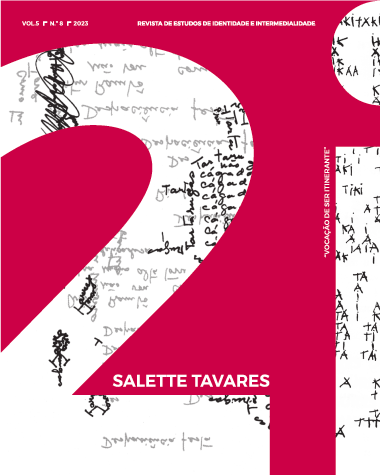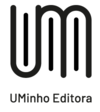Salette Tavares: musicality and the visuality of words in space-time
DOI:
https://doi.org/10.21814/2i.4868Keywords:
Salette Tavares, aesthetic experience, sounds, poetry, imagesAbstract
Following previous studies regarding “between words, sounds and images” in the 1960s and 1970s and on experimentalism in the Portuguese music scene, we propose a reading of specific works by Salette Tavares in dialogue with other 'artistic experimenters' (Jorge Peixinho, Ana Hatherly and Anna Maria Maiolino), meeting the concept formulated by Ernesto de Sousa of 'aesthetic operators' (1969) and thinking about the affinities between demonstrative languages of identity solidity. Tavares participated in the Concerto e Audição Pictórica (1965), a decisive action in the Portuguese panorama. The articulation between the “images of sounds/written words” propagated acts that resonate in the public. “Words are also deeds” (Wittgenstein, 1999). Words are images that are sounds that are choreographic acts. And the reverse is interchangeable, as Art is a game – Schiller or Gadamer dixit. In the aesthetic universe of the poet-visual-aesthete, proposed notations/sounds are identified, visual-sound-verbic compositions are suggested. It reflects on the visual-sign configuration of these reified writings/sounds/movements, potentially intuitive music, mental dynamisms and admitting the haptic dimension that permeates them. Looking/reading/listening provides experiences of completeness, summons presences and enjoyments. Tavares' work provides aesthetic experiences of unveiling, showing signs of fullness, contributing to educational aesthetic experiences, perhaps 'disinterested', to paraphrase Kant.
Downloads
References
Cage, J. (2011). Silence: Lectures and writings. Middletown, Connecticut: Wesleyan Univ. Press.
Dufrenne, M. (1992). Phénoménologie de la Perceptions Esthétique. Paris: PUF.
Eco, U. (1989). Arte e beleza na Estética medieval. Lisboa: Ed. Presença.
_____ (1991). Obra Aberta. São Paulo: Martins Fontes.
Fernandes, M.J. (2018). O Encontro entre a poesia e as artes visuais – Poesia experimental portuguesa 1964-1974. Lisboa: Universidade de Lisboa. https://repositorio.ul.pt/handle/10451/35098
Gadamer, H-G. (2006). Verité et Méthode (1986). Paris: Du Seuil.
Galvão, M. D. (2019). Biografia de Salette Tavares. https://gulbenkian.pt/historia-das-exposicoes/exhibitions/1315/
Gastão, A. M. (2003). Entrevista “Ana Hatherly: meditações sobre a escrita e o ato criador”. Agulha – revista de Cultura # 35 – Fortaleza/São Paulo: agosto 2003.
_____ (2017). “As Tisanas de Ana Hatherly – auto-retrato de um samurai ocidental”. Plural, Puriel. [S.l.], n. 16, sep. 2017. https://www.pluralpluriel.org/index.php/revue/article/download/83/70/
Goodman, N. (1976). Los Lenguages del arte, aproximación a la theoría de los símbolos. Barcelona: Ed. Seix Barral.
Hatherly, A. (1975). A reinvenção da leitura. Lisboa: Futura.
_____ (1979). Desenhoespaço. Porto: Galeria Alvarez. Outubro-Novembro.
_____ (1995). Casa das Musas. Lisboa: Editorial Estampa.
_____ (2006). 463 tisanas. Lisboa: Quimera Ed.
Ingarden, R. (1989). Qu’est-ce qu’une œuvre musicale? Paris: C. Bourgois.
Lambert, M.F. (1997). Fundamentos filosóficos da Estética em Almada Negreiros. Vol. 2. Braga: Universidade Católica Portuguesa.
_____ (2006). “Ana Hatherly: 1 poética, 1 imagética”. Espacio/Espaço Escrito – revista em duas línguas. Madrid.
_____ (2010). “Anna Maria Maiolino”. Order and Subjectivity. Cyprus: Pharos Art Foundation.
Lambert, F. e Fernandes, J. (2001). Porto 60-70: os Artistas e a Cidade. Porto: ASA/ Serralves.
Melo e Castro, E. M. de (1977). In-Novar. Porto: Plátano Ed.
Merleau-Ponty, M. (1945). Phénoménologie de la Perception. Paris: Gallimard.
Moles, A. (1969). Teoria da Informação e percepção estética. Rio de Janeiro: Ed. Tempo Brasileiro.
Nattiez, J. J. (1993). Le combat de Chronos et d’Orphée: Essais. Paris: C. Bourgois.
Negreiros, A. (1982). VER. Lisboa: Arcádia.
Palma, A. (2022). “Aranhas e suas Teias: Alguns (Des)Fios sobre Ana Hatherly e Salette Tavares”. Revista Barroco Digital nº2. www. revista barroco.com.br.
Paz, O. (1993). Los Hijos del Limo, México, Espasa-Calpe.
Reis, J. (2010). “Salette Tavares, Missionária do Alfabeto. Poesia Tipográfica”. Lisboa: CIEBA/Revista Estúdio A. 1, nº 1, p. 217-225. https://repositorio.ul.pt/handle/10451/3694
Schiller, F. (2021) Cartas sobre la educación estética del hombre (1795). Madrid: Alcantilado.
Solnitt, R. (2017). Os homens explicam tudo para mim. São Paulo. Cultrix (ebook).
Souriau, E. (1969). La Correspondance des Arts: Eléments d’Esthétique Comparée. Paris : Flammarion.
Sousa, E. de. (1998). Revolution my body. Lisboa: FCG.
Sutherland, C. (2022). “The intimate geographies of Anna Maria Maiolino”. World Art, 12:1, 25-48, DOI: 10.1080/21500894.2021.2019103
Tavares, S. (1975). “Transcrição da Carta de Salette Tavares para Ana Hatherly”. https://po-ex.net/taxonomia/transtextualidades/metatextualidades-autografas/carta-de-salette-tavares-para-ana-hatherly/
Tavares, S. (1979). “Introdução”. Catálogo da Exposição. Lisboa: Quadrum.
_____ (1989). “Algumas questões de crítica de arte e de estética na sua relação.” Colóquio-Artes. Lisboa: Fundação Calouste Gulbenkian. Nº 82 (setembro 1989), pp. 44-45.
_____ (2019a). IRRAR. Lisboa: Tigre de Papel.
_____ (2019b). O Kágado. Lisboa: Tigre de Papel.
_____ (2019c). Outro Outro. Lisboa: Tigre de Papel.
_____ (2022a). Obra Poética 1957-94. Lisboa: Imprensa Nacional Casa da Moeda (ebook).
_____ (2022b). Sintra no Jardim de Esmeralda. Lisboa: Tigre de Papel.
Torres, R. e Silva, D. (2010). “Teoria da Informação e concepção poética em Salette Tavares”, Revista da faculdade de Ciências Humanas e Sociais, nº 7. https://bdigital.ufp.pt/bitstream/10284/2824/3/240-251.pdf
Torres, R. e Ministro, B. (s.d.). “Biografia Salette Tavares”. https://po-ex.net/tag/salette-tavares/
Wittgenstein, L. (2010) Lecciones y conversaciones sobre estética, psicología y creencia religiosa, Barcelona: Paidós.
Downloads
Published
How to Cite
Issue
Section
License
Copyright (c) 2023 Maria de Fátima Lambert, Francisco Monteiro

This work is licensed under a Creative Commons Attribution-NonCommercial 4.0 International License.


.jpg)










